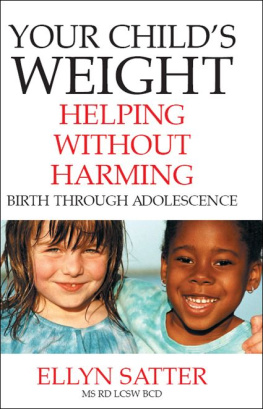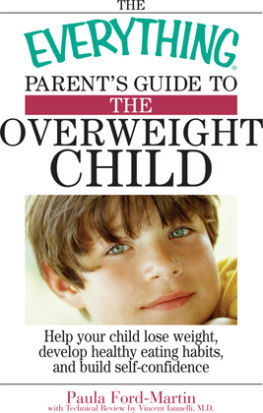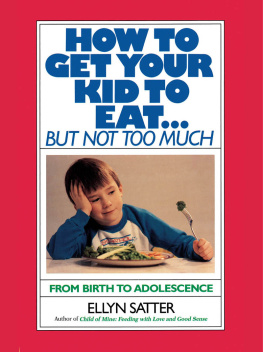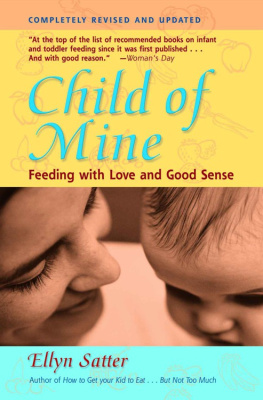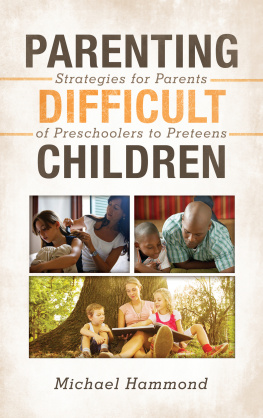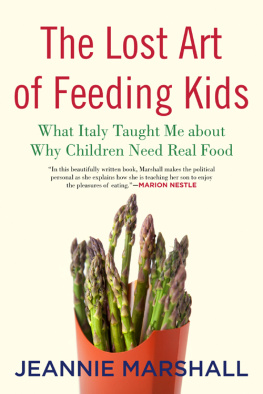
YOUR CHILDS
WEIGHT
HELPING WITHOUT HARMING
BIRTH THROUGH
ADOLESCENCE
ELLYN SATTER
MS RD LCSW BCD

MADISON, WISCONSIN
Your Childs Weight: Helping Without Harming
(Birth Through Adolescence)
Copyright 2005 by Ellyn Satter
Kelcy Press
4226 Mandan Crescent, Suite 57
Madison, WI 53711-3062
(877)844-0857
ISBN 0-9671189-1-3
All rights reserved. No part of this book may be reproduced or transmitted in any form or by any means, electronic or mechanical, including photocopying and recording, or by any information storage and retrieval system, without permission in writing from Ellyn Satter.
Satter, Ellyn
Your childs weight; helping without harming birth through adolescence/Ellyn Satter
p.cm.
Includes bibliographic references and index
ISBN 0-9671189-1-3
1.Pediatrics. Nutrition and feeding of infants and children. 2. The family. Children. Child development 3. The family. Youth. Adolescents I. Title
Production manager: Clio Bushland
Copyeditor: Mary Ray Worley
Layout and Cover Art: Karen Foget
Typesetting: Sherpe Advertising Art
10 9 8 7 6 5 4 3 2 1
Kelcy Press books are available at special discounts for bulk purchases.
For more information, please contact Kelcy press at (877)844-0857 or
see www.KelcyPress.com
Your Childs Weight is distributed to the trade by:
Ellyn Satter Associates
4226 Mandan Crescent, Suite 50
Madison, WI 53711
DEDICATED
to all who parent, in the finest sense.
And to all our children.
ALSO BY ELLYN SATTER
CHILD OF MINE:
Feeding with Love and Good Sense
SECRETS OF FEEDING A HEALTHY FAMILY
HOW TO GET YOUR KID TO EAT
BUT NOT TOO MUCH
ELLYN SATTERS FEEDING IN PRIMARY CARE
PREGNANCY THROUGH PRESCHOOL:
Easy-to-Read Reproducible Masters
ELLYN SATTERS NUTRITION AND FEEDING FOR
INFANTS AND CHILDREN:
Handout Masters
ELLYN SATTERS FEEDING WITH
LOVE AND GOOD SENSE:
Video and Teachers Guide
Ellyn Satters
Montana FEEDING RELATIONSHIP
Training Package
CONTENTS
Emphasize providing, not depriving. Trying to get children to eat less or move more in the name of weight control backfires. It makes them preoccupied with food, inclined to move less when they get the chance, and prone to gain too much weight.
Follow Ellyn Satters Division of Responsibility in Feeding. Feed well, parent well, and accept your childs natural size and shape. Your child needs to be able to trust you to provide; you need to trust him to eat and grow .
Family meals allow your child to do better socially, emotionally, and academically, as well as to grow in the way that is right for her. Mealtime is essential for family timeit is about love, support, and connection.
Children gain too much weight because of how they are fed, not what they are fed. To feed well, including providing family meals, choose food and put together menus that are rewarding to plan, provide, prepare, and eat.
Your child was born wanting to eat, knowing how much to eat, and inclined to grow in the way that nature intended. Good parenting with respect to feeding preserves those qualities from birth and throughout the growing-up years.
Your school-age child starts applying his eating capabilities in the outside world and begins learning to do for himself what you have done for him. Your role is to dole out tasks and responsibilities as your child is able to manage them.
Your adolescent finishes the jobs of learning to provide for herself and preparing to live on her own. Your jobs are the same: challenge without overwhelming; provide support without controlling; give independence without abandoning.
Children are born loving their bodies, curious about them, inclined to move, and driven to be as physically competent as they can possibly be. Good parenting with respect to physical activity preserves those qualities.
Love your child the way she is and teach her to be capable, including loving her body. Stowing your agenda about your childs size and shape opens the door to your parenting her well and feeling good about her.
Growth charts provide a snapshot of your childs physical, nutritional, emotional, and developmental health. Most of your childs growth depends on genetics. To protect against interference, understand growth charts.
STORIES ABOUT
CHILDREN
Sean and Mrs. Thompson, the chubby 8-year-old and his angry mother
Dan, age 17, who looks good
Mary, age 19, whose doctor had said too many fat cells
Wesley, the adult whose mother was a bad cook
Ginny, age 4 years, who couldnt eat at the child care center
Erica, age 6 years, whose parents changed on their own
Leane, age 6 years, who was large at birth
Rachel, age 8 months, who wanted to eat
Zack, who ate until he threw up
Wylie, age 8 years, who was rigidly finicky
Boys, ages 3 and 5 years, whose father nagged about manners
Joshua, age 8 years, who ate on weekends
Annie, age 4 years, who ate at the neighbors
Ginny, age 4 years, who couldnt eat at the child care center
Leane, age 6 years (continued), who was large at birth
Ingrid, age 5 years, who was small at birth
Haley, age 10 years, whose weight shot up off the scale
Salvador, age 10 years, who was in a wheelchair
Maureen, age 19 years, who didnt know to eat
Wesley (continued), adult whose mother was a bad cook
Mall-cruiser, age 13 years
Tyler, who wanted to diet
Benjamin, age 5 years, who thought Head Start was heaven
Jimmy, age 5 years, and the sand castle
Caitlin, age 5 years, had Youthful Tendency Disorder
Jules, age 5 years, needs to learn to play by himself
Stoughton, Wisconsin, physical education students
Leane, age 6 years (continued), who was large at birth
Jacolyn, age 15 years, whose father said, Get my child thin!
Mary, the adult who does not appreciate having been restricted
Ashley, age 19 years, who recommended, Tell them to not not offer food.
Logan, age 5 years, who asked, Am I fat?
Patrick, the first-grader whose teacher criticized
Kevin, the imaginary boy
Curtis, age 6 years, whose weight diverged downward
Melissa, age 6 years, who weight diverged upward
Marcus, age 15 years, the child of extreme size
I see the problem from both ends. I train other health professionals to teach and support positive feeding and parenting. They tell me how much trouble parents today have feeding their children and feeding themselves. I also treat the casualtieschildren and adults whose eating and weight struggles are so pressing that they become engulfing and life-limiting. One informs the other. Defining optimum feeding and parenting illuminates what has gone wrong for those who struggle. Treating those who struggle emphasizes how desperately important it is to do things right in the first place.
Your Childs Weight: Helping Without Harming is about doing things right in the first place. It is about good parentingabout doing an excellent job with respect to feeding and physical activity and letting your child grow up to get the body that is right for her. Doing your job means your child does not have to worry about eating and weight. The two little girls on the cover capture what I want for your childthey are happy and having fun, they know they will be provided for, and weight could not be further from their minds. That is as it should be.
Next page
